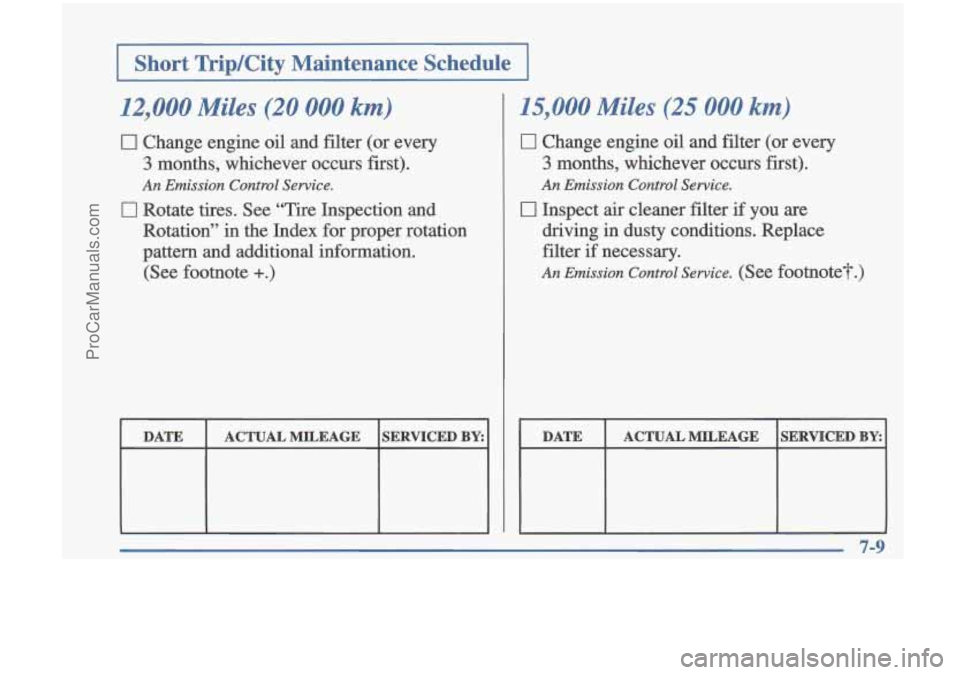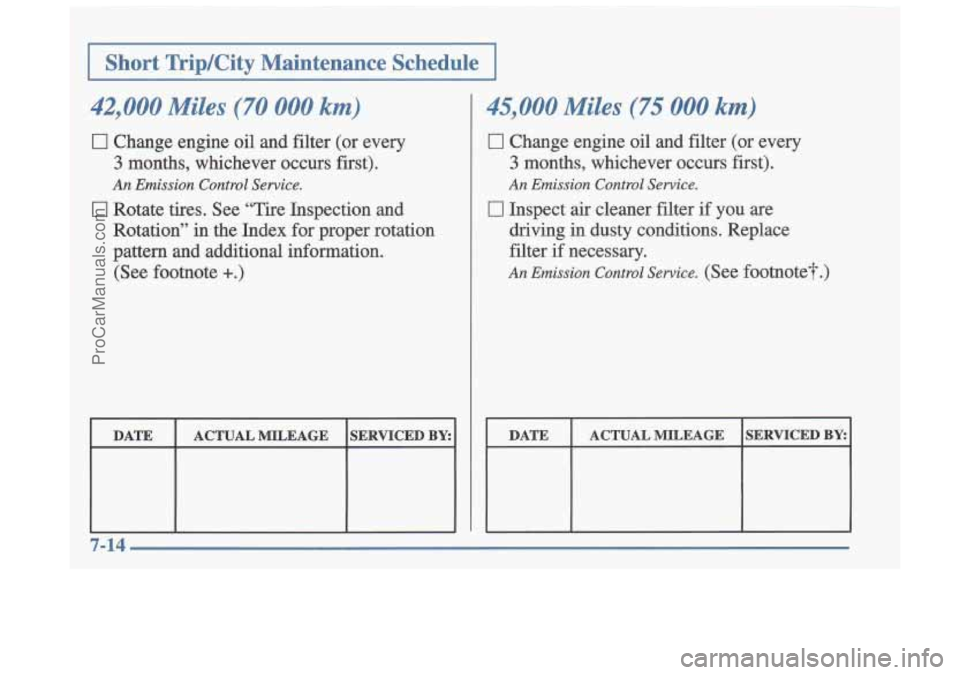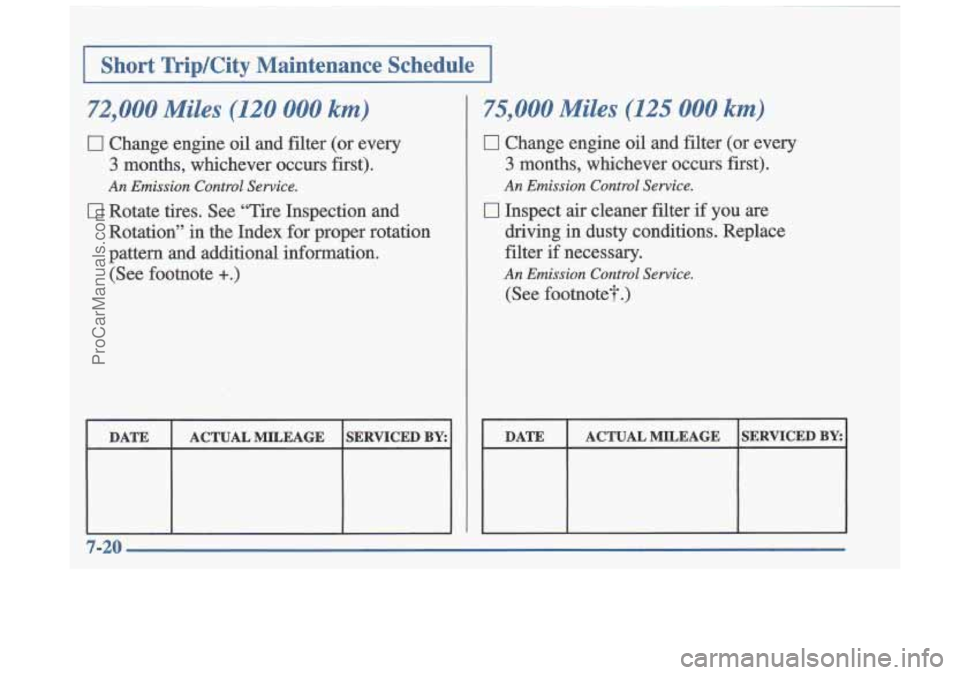1997 OLDSMOBILE CUTLASS air condition
[x] Cancel search: air conditionPage 286 of 353

How This Section is Organized
The remainder of this section is divided into five parts:
“Part A: Scheduled Maintenance Services’’ shows
what to have done and how often. Some
of these
services can be complex,
so unless you are technically
qualified and have the necessary equipment, you should
let your retailer’s service department or another
qualified service ce-%r do these jobs.
Performing maintenance work on a vehicle can
be dangerous.
In trying to do some jobs, you can
be seriously injured.
Do your own maintenance
work only if you have the required know-how
and the proper tools and equipment for the
job.
If you have any doubt, have a qualified
technician do the work.
If you are skilled enough to do some work on your
vehicle, you will probably want
to get the service
information
GM publishes. See “Service and Owner
Publications” in the Index.
“Part B: Owner Checks and Services” tells
you what should be checked and when. It
also explains
what you can easily do to help keep your vehicle in good condition.
“Part C: Periodic Maintenance Inspections” explains
important inspections that your Oldsmobile retailer’s service department or another qualified service center
should perform.
“Part D: Recommended Fluids and Lubricants” lists
some products GM recommends to help keep your
vehicle properly maintained. These products, or their
equivalents, should be used whether you do the work
yourself or have it done.
“Part E: Maintenance Record” provides a place for
you to record the maintenance performed on your
vehicle. Whenever any maintenance is performed, be
sure to write it down in this part. This will help you
determine when your next maintenance should be done.
In addition, it is a good idea to keep your maintenance
receipts. They may be needed to qualify your vehicle for
warranty repairs.
7-3
ProCarManuals.com
Page 287 of 353

Part A: Scheduled Maintenance
Services
Using Your Maintenance Schedule
We at General Motors want to help you keep your
vehicle in good working condition. But we don’t know
exactly how you’ll drive
it. You may drive very short
distances only a few times a week. Or you may drive
long distances all the time in very hot, dusty weather.
You may use your vehicle in making deliveries. Or
you may drive it to work, to do errands or in many
other ways.
Because of all the different ways people use their GM
vehicles, maintenance needs vary. You may even need
more frequent checks and replacements than you’ll find
in the schedules in
this section. So please read this
section and note how you drive. If you have any
questions on how to keep your vehicle in good
condition, see your Oldsmobile retailer. The proper fluids and lubricants to use are listed
in Part D.
Make sure whoever services your vehicle uses these. All
parts should be replaced and all necessary repairs done
before you or anyone else drives the vehicle.
These schedules are for vehicles that:
carry passengers and cargo within recommended
limits. You will find these limits on your vehicle’s
Tire-Loading Information label. See “Loading Your
Vehicle” in the Index.
are driven on reasonable road surfaces within legal
driving limits.
use the recommended fuel. See “Fuel’’ in the Index.
Selecting the Right Schedule
First you’ll need to decide which of the two schedules is
right for your vehicle. Here’s how to decide which
schedule to follow:
This part tells you the maintenance services you should
have done
and when you should schedule them. If you
go to your retailer for your service needs, you’ll know
that GM-trained and supported service people will
perform the work using genuine GM parts.
ProCarManuals.com
Page 288 of 353

Maintenance Schedule
Short Trip/City Definition
Follow the Short Trip/City Maintenance Schedule if any
one of these conditions is true for your vehicle:
Most trips are less than 5 to 10 miles (8 to 16 km).
This is particularly important when outside
temperatures are below freezing.
0 Most trips include extensive idling (such as frequent
driving
in stop-and-go traffic).
Most trips are through dusty areas.
0 You frequently tow a trailer or use a carrier on top of
0 If the vehicle is used for delivery service, police, taxi
your vehicle.
or other commercial application.
One of the reasons you should follow this schedule if
you operate your vehicle under any of these conditions
is that these conditions cause engine oil
to break
down sooner
Short Trip/City Intervals
Every 3,000 Miles (5 000 km): Engine Oil and Filter
Change (or
3 months, whichever occurs first).
Every 6,000 Miles (10 000 km): Tire Rotation.
Every 15,000 Miles (25 000 km): Air Cleaner Filter
Inspection,
if driving in dusty conditions.
Every 30,000 Miles (50 000 km): Air Cleaner Filter
Replacement. Fuel Tank, Cap and Lines Inspection.
Every 50,000 Miles (83 000 km): Automatic Transaxle
Service (severe conditions only).
Every 60,000 Miles (100 000 km): Engine Accessory
Drive Belt Inspection.
Every 100,000 Miles (166 000 km): Spark Plug Wire
Inspection. Spark Plug Replacement.
Every 150,000 Miles (240 000 km): Cooling System
Service (or every
60 months, whichever occurs first).
These intervals only summarize maintenance services.
Be sure to follow the complete maintenance schedule
on
the following pages.
ProCarManuals.com
Page 289 of 353

Maintenance Schedule
Follow this maintenance schedule only if none of the
conditions from the Short TripKity Maintenance
Schedule
is true. Do not use this schedule if the vehicle
is used for trailer towing, driven in a dusty area or used
off paved roads. Use the Short TripKity schedule for
these conditions.
Driving a vehicle with a filly warmed engine under
highway conditions causes engine oil to break
down slowel:
Every 7,500 Miles (12 500 km): Engine Oil and Filter
Change (or every
12 months, whichever occurs fist).
Tire Rotation.
Every 30,000 Miles (50 000 km): Air Cleaner Filter
Replacement. Fuel Tank, Cap and Lines Inspection.
Every 50,000 Miles (83 000 km): Automatic Transaxle
Service (severe conditions only).
Every 60,000 Miles (100 000 km): Engine Accessory
Drive Belt Inspection.
Every 100,000 Miles (166 000 km): Spark Plug Wire
Inspection. Spark Plug Replacement.
Every 150,000 Miles (240 000 km): Cooling System
Service (or every
60 months, whichever occurs first).
These intervals only summarize maintenance services.
Be sure
to follow the complete maintenance schedule on
the following pages.
ProCarManuals.com
Page 292 of 353

1 Short TripKity Maintenance Schedule I
12,000 Miles (20 000 km)
0 Change engine oil and filter (or every
3 months, whichever occurs first).
0 Rotate tires. See “Tire Inspection and
Rotation” in the Index for proper rotation
pattern and additional inforrnation. (See footnote
+.)
An Emission Control Service.
I I I 1
DATE
SERVICED BY: ACTUAL MILEAGE
15,000 Miles (25 000 km)
17 Change engine oil and filter (or every
3 months, whichever occurs first).
0 Inspect air cleaner filter if you are
An Emission Control Service.
driving in dusty conditions. Replace
filter if necessary.
An Emission Control Service. (See footnote’f.)
I DATE I ACTUAL MILEAGE SERVICED BYJ
7-9
ProCarManuals.com
Page 297 of 353

I I Short TripKity Maintenance Schedule I
I 42,000 Miles (70 000 km)
0 Change engine oil and filter (or every
3 months, whichever occurs first).
An Emission Control Service.
0 Rotate tires. See “Tire Inspection and
Rotation”
in the Index for proper rotation
pattern and additional information.
(See footnote
+.)
DATE ACTUAL MILEAGE SERVICED BY:
45,000 Miles (75 000 km)
0 Change engine oil and filter (or every
3 months, whichever occurs first).
0 Inspect air cleaner filter if you are
An Emission Control Service.
driving in dusty conditions. Replace
filter
if necess-ary.
An Emission Control Service. (See footnote?.)
t I
DATE ACTUAL MILEAGE SERVICED BY:
7-14
ProCarManuals.com
Page 303 of 353

I Short TripKity Maintenance Schedule I
72,000 Miles (120 000 kt)
0 Change engine oil and filter (or every
3 months, whichever occurs first).
An Emission Control Service.
0 Rotate tires. See “Tire Inspection and
Rotation” in the Index for proper rotation
pattern and additional information. (See footnote
+.)
DATE SERVICED BY: ACTUAL MILEAGE
- ~~ .. ~ ~~
75,000 Miles (125 000 km)
0 Change engine
oil and filter (or every
3 months, whichever occurs first).
0 Inspect air cleaner filter if you are
An Emission Control Service.
driving in dusty conditions. Replace
filter
if necessary.
An Emission Control Service.
(See footnote.%.)
DATE SERVICED BY: ACTUAL MILEAGE
ProCarManuals.com
Page 324 of 353

Part C: Periodic Maintenance
Inspections
Listed below are inspections and servlces which should be
performed at least twice a year (for instance, each spring
and fall). You should let your
GM retailer’s service
department or other
qualified service center do these jobs.
Make sure
any necessary repairs are completed at once.
Proper procedures to perform these services may be
found
in a GM service manual. See “Service and Owner
Publications” in the Index.
Steering, Suspension and Front Drive Axle
Boot and Seal Inspection
Inspect the front and rear suspension and steering
system for damaged, loose or missing parts, signs of
wear or lack of lubrication. Inspect the power steering
lines and hoses for proper hook-up, binding, leaks,
cracks, chafing, etc. Clean and then inspect the drive
axle boot seals for damage, tears or leakage. Replace
seals if necessary.
Exhaust System Inspection
Inspect the complete exhaust system. Inspect the body near
the exhaust system.
Look for broken, damaged, missing or
out-of-position parts
as well as open seams, holes, loose connections or other conditions
whch could cause a heat
build-up in the floor pan or could let exhaust fumes into
the vehicle.
See “Engine Exhaust” in the Index.
Radiator and Heater Hose Inspection
Inspect the hoses and have them replaced if they are
cracked, swollen or deteriorated. Inspect all pipes,
fittings and clamps; replace
as needed.
Throttle Linkage Inspection
Inspect the throttle linkage for interference or binding,
and for damaged or missing parts. Replace parts as
needed. Replace
any cables that have high effort or
excessive wear.
Do not lubricate accelerator and cruise
control cables.
Brake System Inspection
Inspect the complete system. Inspect brake lines and
hoses for proper hook-up, binding, leaks, cracks,
chafing, etc. Inspect disc brake pads for wear and rotors
for surface condition.
Also inspect drum brake linings
for wear and cracks. Inspect other brake parts, including
drums, wheel cylinders, calipers, parking brake, etc. The
parking brake is self-adjusting and no manual adjustment is required. You may need
to have your
brakes inspected more often
if your driving habits or
conditions result
in frequent braking.
7-41
ProCarManuals.com